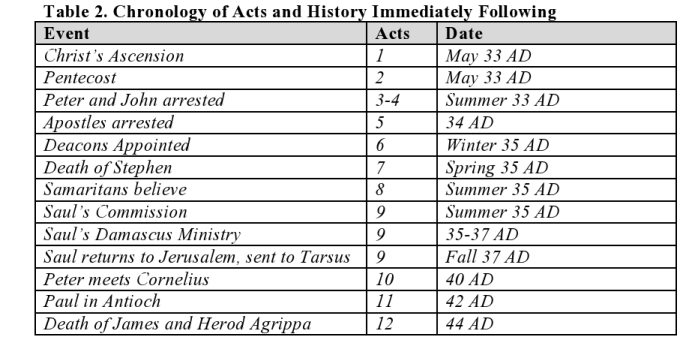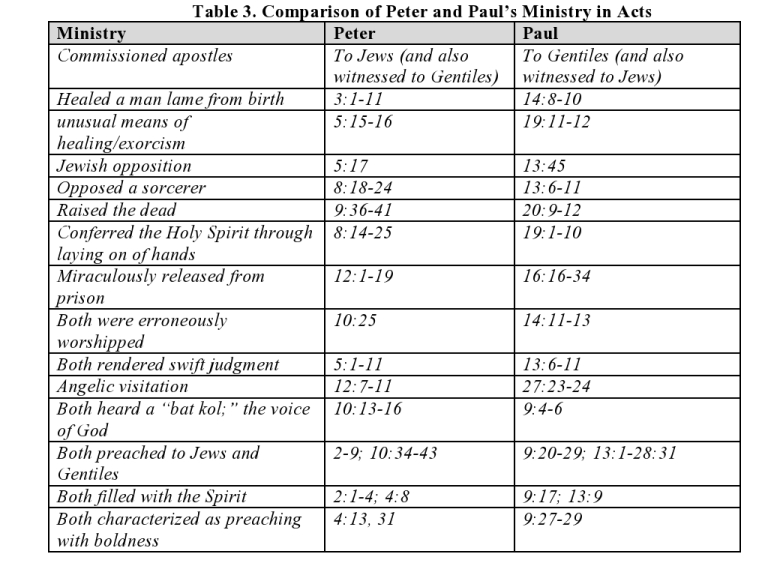|
You will receive power when
the Holy Spirit has come upon you; and you shall be My witnesses
both in Jerusalem, and in all Judea and Samaria, and even to the
remotest part of the earth.
~ Acts 1:7-8 ~
|
*
Every so often, a commentary comes to the attention of the
student of Scripture that strikes him or her as being head and shoulders
above the crowd. Steven Charles Ger's Acts: Witnesses to the World
has struck this editor and AMC's board secretary Mottel Baleston in just
such a way. For this reason, we have decided to present Acts in its
entirety - not just for the wealth of information that may be gained
from its study, but, as Mottel stated, as a model for how a Bible study
ought to be done. Has God given you the gift of teaching? Perhaps you'll
be next to pick up the torch for this level of teaching. ~ editor
*
INTRODUCTION: BACKGROUND TO ACTS
Part 2 of 3
Links to previous increments of Acts:
Witnesses to the World
may be found in our Library.
*
PURPOSE OF
ACTS
Perhaps as many as a dozen plausible
reasons have been proposed over the centuries to
explain the occasion of Luke's writing of Acts. Countless students have
valiantly, but
futilely, applied themselves to the task of narrowing down the list to
one overarching
purpose. Yet to limit Luke to only one purpose does injustice to his
broad and
monumental work. Although addressed to only one individual, his patron,
Theophilus, it
must be recognized that Luke wrote with multiple purposes in mind. It is
possible to
ascertain, upon analysis of the Acts narrative, four particularly
compelling purposes.
Historical: The primary purpose of Luke's work is historical. It is the
sequel to his
gospel, which was the chronological account of Jesus' earthly ministry,
and Acts resumes
with the record of Jesus' continued ministry through the agency of His
apostles (1:1).
Luke wrote this account to carefully and systematically trace the growth
and geographical
expansion of the church over its first three decades (2:47; 5:14; 6:7;
9:31; 12:24; 16:5;
19:20). While acutely selective in his choice of material, Luke provides
every necessary
historical highlight to understand the development of the church from
its origins in
Jerusalem through its climactic extension to Rome (see Table 2).

Theological: Luke's purpose went far beyond the historical. Another
purpose Luke
has is theological in nature. He wrote Acts to validate that
Christianity is the legitimate
development of God's plan and program for both Jews and Gentiles as
engineered by the
Holy Spirit (1:5-8; 2:1-47; 5:1-11; 6:5; 8:14-17; 10:44-47; 13:1-4;
19:1-7). Luke reveals
the continuity between what God had promised to Israel through covenant
and prophecy
and what has been received by the church.
Luke also carefully demonstrates that God's promises to Israel have not
been
exhausted by the initiation of the church age. Although only a Jewish
remnant has
currently accepted their messiah and at present the nation stands in
opposition to him, at
some point in the future Israel will acknowledge Jesus as their Lord,
savior and king
(3:21).
Acts, however, is not a theological treatise. It must always be
remembered while
studying Acts that Luke is not concerned with developing doctrine. This
is a book of
historical descriptions, not propositional prescriptions. His intent was
not to make
normative for all believers through all time the unique and unrepeatable
experiences of
Pentecost, Saul's Damascus Road encounter, or to standardize various
apostolic
decisions, miracles and judgments.
As a historian, Luke is concerned with the practical application of
these new and
unprecedented theological developments. He defines the nature,
structure, and practices
of this new community of believers. He describes the relationship of
this community to
its adherents, to the unbelieving and often hostile Jewish community, to
the Temple, in
Judaism in general, and to the power of the Roman Empire. Finally, he
relates the only
major theological controversy to arise within the first three decades of
the Church, that of
Gentile inclusion into the church on an equal basis with Jews.
Apologetic: Luke also writes with an apologetic purpose in mind. He
proves that,
while the Jewish leadership consistently opposed the Christian movement
from the start,
the Roman civil authorities demonstrate no such antagonism (13:12;
16:39; 18:15-17;
19:37-40; 24:23; 25:19-25; 26:31-32; 28:30-31). Although Judaism viewed
Christianity
as an ominous and menacing sect, the Roman Empire perceived no such
threat from the
burgeoning movement, despite the fact that its founder had been executed
as a criminal
by Rome.
Luke assembles a thorough stream of evidence to establish that
Christianity was not a
political movement, but primarily a religious one; a movement with a
profound Jewish
heritage and deeply rooted in Hebrew Scripture. Therefore, by
highlighting Christianity's
Jewish association, Luke sought to demonstrate that the new faith should
share Judaism's
status as a recognized, legally accepted religion within the Empire.
Biographical: Luke's final purpose is a biographical one. In Acts, Luke
firmly
associates Paul's apostolic ministry with the apostolic ministry of
Peter. By developing
this strong literary connection between Peter and Paul, Luke
demonstrates the full
apostolic authority of Paul. Time and again, example upon example, the
record of Acts
reveals that whatever Peter was empowered to do, Paul was so empowered
as well. Luke
carefully presents these two men as absolute equals in supernatural
ability, apostolic
gifting and divine commission (see Table 3).

THEME
AND STRUCTURE OF ACTS
The theme, or "big idea," of Acts
emanates from the crucial opening passage in the book,
which contains Jesus' commission to his apostles,
you will be My
witnesses in
Jerusalem, and in all Judea and Samaria, and to the ends of the earth
(Acts 1:8). This
central idea combines each of Luke's four purposes into one coherent
whole: identifying
message (witness of Jesus, i.e., the gospel), messenger (the apostles)
and location of
delivery (Jerusalem, Judea and Samaria, the ends of the earth).
With adroit literary skill, Luke uses this divine apostolic commission
to organize his
book in two major ways: geographical and biographical.
Luke's geographical structure arranges the book according to the
location of the
gospel's delivery, from Jerusalem (1:1-8:4) to Judea and Samaria
(8:5-12:25) and to the
ends of the earth (13:1-28:31).
Luke's biographical structure neatly divides the book into two parts,
which are mirror
images of each other (1:1-12:25 and 13:1-28:31). While the second half
of Acts is longer
in verbal content than the first (more chapters and verses), Luke has
arranged both halves
to be equal in chronological content. Luke has broken his coverage of
the first twenty-nine years of church history into two equal parts consisting of
fourteen-and-one-half
years apiece.
Additionally, each fourteen-and-one-half year historical period has its
own "leading
man," the principal apostle with whom the narrative is concerned
throughout that period;
first Peter, then Paul.
He further subdivides each fourteen-and-one-half year period into a
twelve-and-one-half year and a two-year period. The two-year periods bracket the Acts
narrative. The
story begins with the first two-year period (1:1-8:4) and takes place
solely in Jerusalem,
the birthplace of the church. Luke expends seven chapters relating this
defining stage in
the church's history. The two-year period which concludes the book
(28:14-31) takes
place solely in Rome, the geographic goal of Paul's apostolic witness.
Luke summarizes
this final stage in only half a chapter.
The core of the book takes place within the two twelve-and-one-half year
periods and
chronicles the gospel's transition from Jerusalem to Rome. It also
shifts the apostolic
focus from Peter to Paul (see Table 4).
The key word in Acts is "witness," martus, and is used twenty-one
times in Acts.
This was to be the main function of the apostles and their associates.

THE FIVE TRANSITIONAL
CIRCUITS IN ACTS
Acts is a unique component within the
NT corpus. It is only the book of Acts that
recounts the historical record of the church's first three decades. The
evolution fromsmall Jewish sect to universal movement was not always smooth. The
history of apostolic
activity serves as a transition between the resurrection of Christ and
our own post-apostolic era. Acts serves as the bridge over the following five
transitional pathways, or
circuits.
First, there is a historical transition as the repercussions of Jesus
passing over the
mantle of His ministry to His closest followers are traced. The book of
Acts records the
developing apostolic application of the ministry of Jesus.
Second, there is a cultural and geographic transition as the church
developed from
its initial Jewish milieu to its eventual expanded, international scope.
It was a long road
from Jerusalem to Rome, and Acts records the essential elements of that
journey.
In Acts, we see the circumstances by which the door to the original
Jewish
community of believers is unlocked to Gentiles. We learn how spiritual
equality was
established and recognized between Jews and Gentiles within the
broadened community
of faith. In Acts, we are privy to the theological difficulties and the
very practical
obstacles to Gentile equality with which the Jewish community needed to
wrestle and
ultimately overcome.
In Acts, we also see the paradox inherent in such a specifically Jewish
message being
rejected by the majority of Jews, yet accepted so willingly by Gentiles
who lacked any
biblical background or education.
There is also an evangelistic directional transition, with the nation of
Israel evolving
from the point of terminus in finding God to its serving as the point of
departure. In the
Hebrew Scriptures and the gospels, a centripetal ministry is modeled,
where Israel is the
center of God's activity, and one who seeks Him must necessarily come
through the
Jewish people. In Acts, God's activity diffuses, and the rotation of
outreach has reversed
to one of centrifugal force, where representatives from Israel spin out
into the world,
bringing God to the nations. The narrative traces a steady progression
outward from
Jerusalem, through Israel and to the nations. This was not always a
natural or willing
transition, and circumstances often provided the catalyst to make this
transition.
In addition, there is a theological transition, which moves the church
from the
personal presence of Jesus to the personal and internal presence of the
Holy Spirit. As
Jesus directed his apostles throughout His earthly ministry, Acts
records the Spirit's
direction and guidance of the church. With 2000 years difference between
the twenty-first century and the first century, it is sometimes difficult to
appreciate just how radical it
was for this movement to succeed without the physical presence of its
founder and leader.
There is a major difference between Jesus being among believers and the
Holy Spirit
dwelling within believers. Acts records the unprecedented genesis and
consequence of
this divergence.
In addition, Acts records the movement away from the Law as a way of
life and
means of relating to God, to that of grace. Following the resurrection
and exaltation of
Jesus, the Mosaic Law has been abrogated (Acts 15:1-29). (6) A new
dispensation had
dawned, characterized by the law of Christ, not Moses (1 Cor. 9:21; Gal.
6:2). Almost
from the beginning, the early church was accused of preaching that, in
some fashion, the
Law had been nullified as a way of life (6:11-14; 18:13; 21:21).
The ramifications of Jesus' resurrection and exaltation as Messiah and
the subsequent
creation of a new entity, the church community, would force what had
begun as a Jewish
sect to necessarily make the painful break away from the Jewish
religion. Acts traces the
church's break with Judaism from original fracture (4:1-2) to gaping
chasm (25:2-3).
While the church broke from Judaism as a system, it did not break from
Israel as a
nation. As the Acts narrative concludes, the church is still heavily
Jewish in character.
The abrogation of the Law does not imply that the early church abandoned
the Law
wholesale or ceased observing Jewish customs and traditions (Acts
21:20). The early
church regularly attended Temple (2:46; 3:1) and synagogue (13:14),
observed the
Sabbath (15:21) and circumcision (16:3), and performed ceremonial vows
(18:18; 21:24).
Only gradually, over its first decade and a half, did the church as a
whole begin to
realize that the Law of Moses was no longer operative as the standard
way of life for
believers. This revolutionary transition slowly came to be understood
with the
incorporation of Gentiles into the church (11:1-18). Gentiles did not
need to become Jews
prior to becoming Christians.
The Mosaic Law, however, did not cease to be recognized by the early
church as
Holy Scripture, God's divine revelation. It continued to be their
central basis of
instruction, guidance, and source of messianic prophecy. In fact, the
Law's greatest
purpose for the early church was in its prophetic testimony of the
Messiah. It contains the
promises of the Messiah, now fulfilled in Jesus (Acts 3:13, 22-23;
24:14; 26:22-23).
Finally, there is a christological transition, which moves Israel and
the world from
an anticipated messiah to a returning messiah. With the death and
resurrection of Christ,
God's expectations of His people Israel and of the nations undergo a
radical adjustment.
Although, from the beginning, salvation has ultimately always been by
grace through
faith, the specific content of that faith develops over time with each
new revelation. Since
the dawn of the church age, following the resurrection and ascension of
Jesus, salvation is
solely through faith in Him. Acts records the passion of the apostles as
they energetically
broadcast the new requirements for the salvation of Jew and Gentile
alike.
This relates to the final aspect of Acts' christological transition, the
generation of
devout Jews and God-fearing Gentiles whose lives spanned the period
prior to and
following Christ's resurrection. Similar to the generational torch which
passed during
Israel's forty year wilderness sojourn, there was a transitional period
of apostolic activity
which roughly extended until the death of the final member of the
generation which came
of age prior to Christ's resurrection.
FOOTNOTES
6. Darrell L. Bock, “A Theology of Luke-Acts,” in Roy B. Zuck and
Darrell L. Bock, eds., A Biblical
Theology of the New Testament (Chicago: Moody Press, 1994), 138.
STUDY
QUESTIONS
3. List four purposes of Acts.
4. Describe the theme and structure of Acts.
5. Describe the five transitions of Acts.
*
Acts: Witnesses to the World
Copyright © 2004, Tyndale Theological Seminary





